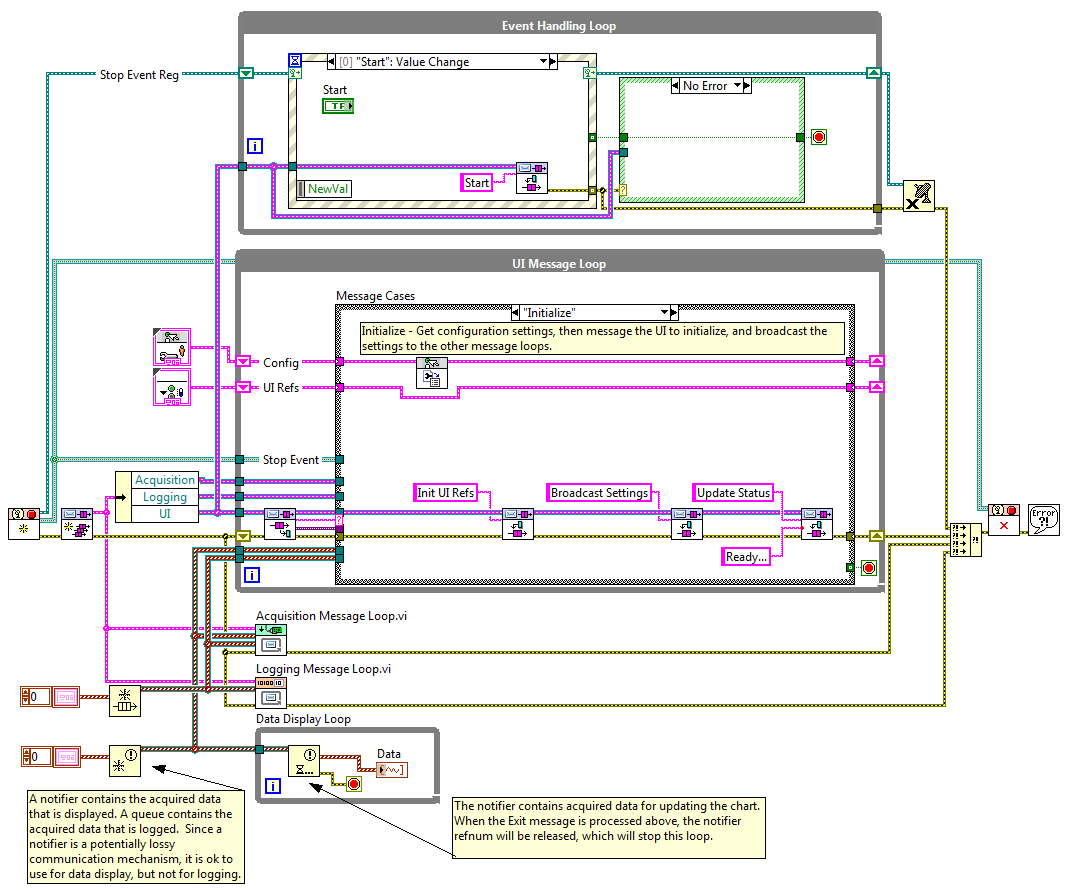Visual Programming
graphical models for programming, using graphs, icons or other graphical representaions of processes.
languages/environments
Category:Visual_programming_languages and often using the Dataflow_programming paradigm
visual representations of various visual programming languages (i.e. pictures)
“There didn’t seem to be a place on the net where someone could easily see what all the different visual programming languages look like. So, this post is just a lot of really cool screenshots and images of different visual programming languages. Have fun checking them all out.” from http://blog.interfacevision.com/design/design-visual-progarmming-languages-snapshots/
Luna
“Visual and textual functional programming language with a focus on productivity, collaboration and development ergonomics.”
thingLab
- constraint based visual programming or extensible modelling system? http://www.cosc.canterbury.ac.nz/~wolfgang/NewHome/cosc414/projects/thinglabFolder/html/thinglab.html
lanaguages derived from pd
- pd (pure data) by miller puckette → http://pure-data.org (see also gem/gridflow/etc)
- max → http://www.cycling74.com (now with jitter!)
- jmax → ircam
ascii-art patching via perl → http://doc.gold.ac.uk/~ma503am/alex/textual-patching/
OpenMusic
- visual music programming in lisp http://www.ircam.fr/equipes/repmus/OpenMusic/
biobike
visPro
diaGen
Drakon
“DRAKON Editor is a free tool for authoring DRAKON diagrams. It also supports sequence diagrams, entity-relationship and class diagrams […] Software developers can build real programs with DRAKON Editor. Source code can be generated in several programming languages, including Java, Processing.org, C#, C/C++ (with Qt support), Python, Tcl, Javascript, Lua and Erlang.”
other...
using petri-nets →
graph rewriting →
- progress; programming using graph rewriting (related: GraphDrawing) http://www-i3.informatik.rwth-aachen.de/research/projects/progres/
- HOPS graphically interactive program development and program transformation system based on acyclic term graphs.
reading
- bibliographies(research focused) →
- “Programming in Three Dimensions” http://research.compaq.com/SRC/personal/najork/thesis/
- “A metatool for visual language development” http://www.rddvs.com/thesis/
- papers from 'performing grapics“ http://www.pgc.com/pgc/home-stuff/papers-list.html
- Tinkertoy, by Edel, M
- the journal of visual languages and computing
usability analysis
- using 'cognitive dimesions' http://citeseer.nj.nec.com/77679.html
- and further (to extract from archive.org)
refs/links
tangents
ARK and VIPR follow up references
http://www.open-video.org/details.php?videoid=8050
Burnett, M. M. and Baker, M. J. “A classification system for visual programming languages.” J. Visual Languages and Computing, pp. 287-300, September 1994. http://citeseer.nj.nec.com/burnett94classification.html “Visual Programming Languages: A Survey” http://www.cs.berkeley.edu/~maratb/cs263/paper/paper.html and http://citeseer.nj.nec.com/boshernitsan97visual.html
comments from kuro5hin thread
Gilles Kahn is responsible for much of the formalism that exists in the dataflow world today. He invented and studied Kahn process networks (with Dave MacQueen) back in the 70's. Since then many computer scientists have invented a whole universe of dataflow models, many of which are base on Kahn's early work.
In the late 80's Edward Lee began studying dataflow models and has published some fundamental papers in the field. His research group is responsible for the Ptolemy project which is a graphical programming environment that permits programming in a mixture of dataflow-ish models. http://ptolemy.eecs.berkeley.edu/~eal/
Related to dataflow programming is the work on the pi calculus, begun by Robin Milner (the inventer of ML) in the early 80's. The goal of pi calculus research is to come up with a simple unifying model of concurrent programming, similar to the lambda calculus for sequential programming. Many pi calculus related links have been assembled at http://lamp.epfl.ch/mobility/
khoros might be interesting, but its proprietary,. http://www.khoral.com/
papers / citations
“DATAFLOW PROCESS NETWORKS” Edward A. Lee and Thomas M. Parks, Proceedings of the IEEE, vol. 83, no. 5, pp. 773-801 May, 1995 http://citeseer.nj.nec.com/lee95dataflow.html
KahnNetworks
Nan C. Shu “Visual Programming: Perspectives and Approaches.” 199-221, IBM Systems Journal, Volume 38, 1999
visual programming in music
max/msp/pd/jmax obviously,. ircam has been quite influential in devlopeing enviroments aorund the “patch and wires” metaphor, with serveral approaches being taken over the years (including OpenMusic above) ., . papers
- “Visual Programming in Music” by G�rard Assayag http://catalogue.ircam.fr/articles/textes/Assayag95/
- “An Object Oriented Visual Environment for Musical Composition” by Assayag, Agon, Fineberg et Hanappe. (describing OpenMusic) http://catalogue.ircam.fr/articles/textes/Assayag97a/
- “Open Music + Music Space = Open Space” http://www.ircam.fr/equipes/repmus/RMPapers/openspace/
OpenDX
- related: InfoViz
taxonomy
from (Nan C. Shu)
- Visual programming
- visual environment
- visualisation of…
- data, or info. about data
- program and/or its execution
- software design
- visual training
- visual langugages for…
- handling visual information
- supporting visual interaction
- programming with visual expresions
- visual programming languages
- diagrammatic systems
- iconic systems
- form systems
notes → Visual Programming Notes
